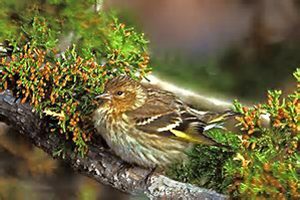 “Hey, what’s that heavily streaked sparrow on the feeder? Looks very strange. There are lots of sparrows with light streaking, but I don’t think I’ve ever seen one with such heavy marks all over! Oh, it’s moving off—omigosh, it’s got yellow wings!! What the heck is it?”
“Hey, what’s that heavily streaked sparrow on the feeder? Looks very strange. There are lots of sparrows with light streaking, but I don’t think I’ve ever seen one with such heavy marks all over! Oh, it’s moving off—omigosh, it’s got yellow wings!! What the heck is it?”
Your puzzling “sparrow” is a Pine Siskin, a species that Pete Dunne calls “the bratty, streaky, little pipsqueak at the thistle feeder.” With its wings closed, sitting on your feeder, the yellow in its prominent wingbars may be too subtle to notice, but the color becomes obvious when a bird spreads its wings, revealing the broad yellow across its wings and back. Siskins are quite common, but easily overlooked during the breeding season when birders are commonly focused on more colorful, interesting birds such as warblers and vireos. Pine Siskins, like several other finches, are primarily occupants of the Canadian biome, the “spruce-moose” habitat that reaches across southern Canada and northward into Alaska, but also into mountainous areas of the western U.S. In this habitat, their main food is seeds of spruce, alder, and other trees and bushes, but they also eat considerable numbers of insects, especially caterpillars and aphids. After breeding, flocks of Siskins tend to leave their characteristic forests of spruce and other conifers and occupy fields with thistles and wild sunflowers, so they become common locally in many places, such as BFJ Nisqually Wildlife Refuge.
Siskins share another population feature with some other birds of their Canadian breeding grounds, including other finches. The complexities of predator-prey (or feeder-food) relationships means that populations go through regular ups and downs in numbers; a scarcity of regular food puts pressure on populations of feeders to look elsewhere, and we sometimes experience this as sudden winter influxes of these more-northern birds. So occasionally large numbers of Siskins—sometimes huge flocks—invade from the north. But even without such periodic invasions, Siskins are very sociable birds that commonly feed in flocks even during breeding season, and they are among the winter flocks that so obviously move along from leafless tree to leafless tree, often mixed with other finches, such as redpolls and goldfinches. (from Jan/Feb 2017 Echo newsletter, by Burt Guttman)







